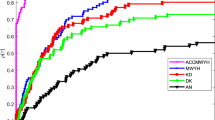Abstract
The proximity operator of a convex function is a natural extension of the notion of a projection operator onto a convex set. This tool plays a central role in the analysis and the numerical solution of convex optimization problems. It has recently been introduced in the area of signal processing, where it has become increasingly important. However, so far there has been no research on independent component analysis (ICA) in this framework. In this paper, we focus on this problem and propose the fast proximal-gradient method for ICA, termed as FastPG-ICA, in blind source separation (BSS) problem. We derive the new update rule of the unmixing matrix from the viewpoint of the fast proximal gradient. It achieves a better separation performance than that of the traditional ICA method, such as complex FastICA (cFastICA) proposed by Bingham and Hyvärinen. Simulations demonstrate the effectiveness of our proposed method.
Similar content being viewed by others
References
S. Amari, A. Cichocki, H.H. Yang, A new learning algorithm for blind signal separation, in Advances in Neural Information Processing Systems, ed. by Touretzky, D.S., Mozer, M.C., Hasselmo, M.E., vol. 8, pp. 757–763. MIT Press, Cambridge (1996)
J. Anemüller, T.J. Sejnowski, S. Makeig, Complex independent component analysis of frequency-domain electroencephalographic data. Neural Netw. 16(9), 1311–1323 (2003)
A. Beck, M. Teboulle, Fast gradient-based algorithms for constrained total variation image denoising and deblurring problems. IEEE Trans. Image Process. 18(11), 2419–2434 (2009)
A. Beck, M. Teboulle, A fast iterative shrinkage-thresholding algorithm for linear inverse problems. SIAM J. Imag. Sci. 2(1), 183–202 (2009)
A. Beck, M. Teboulle, Gradient-based algorithms with applications to signal-recovery problems, in Convex Optimization in Signal Processing and Communications, ed. by Palomar, D.P., Eldar, Y.C., pp. 42–88. Cambridge University, Cambridge (2010)
E. Bingham, A. Hyvärinen, A fast fixed-point algorithm for independent component analysis of complex valued signals. Int. J. Neural Syst. 10(1), 1–8 (2000)
P.L. Combettes, J.C. Pesquet, Split convex minimization algorithm for signal recovery, in IEEE ICASSP (2009), pp. 685–688
O. Diene, A. Bhaya, Conjugate gradient and steepest descent constant modulus algorithms applied to a blind adaptive array. Signal Process. 90(10), 2835–2841 (2010)
S.C. Douglas, Fixed-point algorithms for the blind separation of arbitrary complex-valued non-Gaussian signal mixtures. EURASIP J. Adv. Signal Process. 2007, 1–15 (2007)
J. Gao, X. Zhu, A.K. Nandi, Independent component analysis for multiple-input multiple-output wireless communication systems. Signal Process. 91(4), 607–623 (2011)
A. Hyvärinen, J. Karhunen, E. Oja, Independent Component Analysis. Wiley, New York (2001)
A. Hyvärinen, E. Oja, Independent component analysis by general non-linear Hebbian-like learning rules. Signal Process. 64, 301–313 (1998)
M.E. Johnson, Computer generation of the exponential power distributions. J. Stat. Comput. Simul. 9, 239–240 (1979)
W.B. Mikhael, R. Ranganathan, T. Yang, Complex adaptive ICA employing the conjugate gradient technique for signal separation in time-varying flat fading channels. Circuits Syst. Signal Process. 29, 469–480 (2010)
S. Pan, J.-S. Chen, A proximal gradient descent method for the extended second-order cone linear complementarity problem. J. Math. Anal. Appl. 366, 164–184 (2010)
Author information
Authors and Affiliations
Corresponding author
Rights and permissions
About this article
Cite this article
Zhang, H., Li, L. & Li, W. Independent Component Analysis Based on Fast Proximal Gradient. Circuits Syst Signal Process 31, 583–593 (2012). https://doi.org/10.1007/s00034-011-9317-6
Received:
Revised:
Published:
Issue Date:
DOI: https://doi.org/10.1007/s00034-011-9317-6




